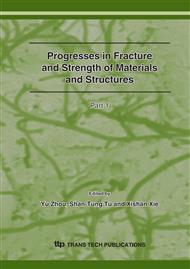p.1675
p.1679
p.1683
p.1688
p.1692
p.1696
p.1700
p.1704
p.1708
Study on the Carbides and the Interface Bonding in Surfacing Welding Metal
Abstract:
The interface bonding between the carbides and the solid solution matrix is studied in surfacing welding metal of Fe-Nb-Ti-V-C alloy system. Both the quenched welding droplets and the deposited metal are investigated by means of SEM and TEM. In the deposited metal, the carbides are dispersed, and the matrix is low carbon martensite. According to welding metallurgical characteristics, it is deduced that the carbides are formed during the droplets stage and then transmit into the welding pool. When the welding pool solidify, the carbides serve as nucleation site, so the interface between the carbides and the matrix is clean and free from other reactants. The selected area electron diffraction (SAED) analysis reveals that the mismatch between the two phase is δ= (6.1~8.3)%, and there exist a crystal parallel relationship at the interface: (002)α-Fe // (220)(NbTiV)C. The metallurgical bonding between the carbides and the matrix favors to prevent the carbides to detach from the matrix during wear process, so the surfacing welding metal can achieve good wear-resistance.
Info:
Periodical:
Pages:
1692-1695
Citation:
Online since:
September 2007
Authors:
Keywords:
Price:
Сopyright:
© 2007 Trans Tech Publications Ltd. All Rights Reserved
Share:
Citation:


